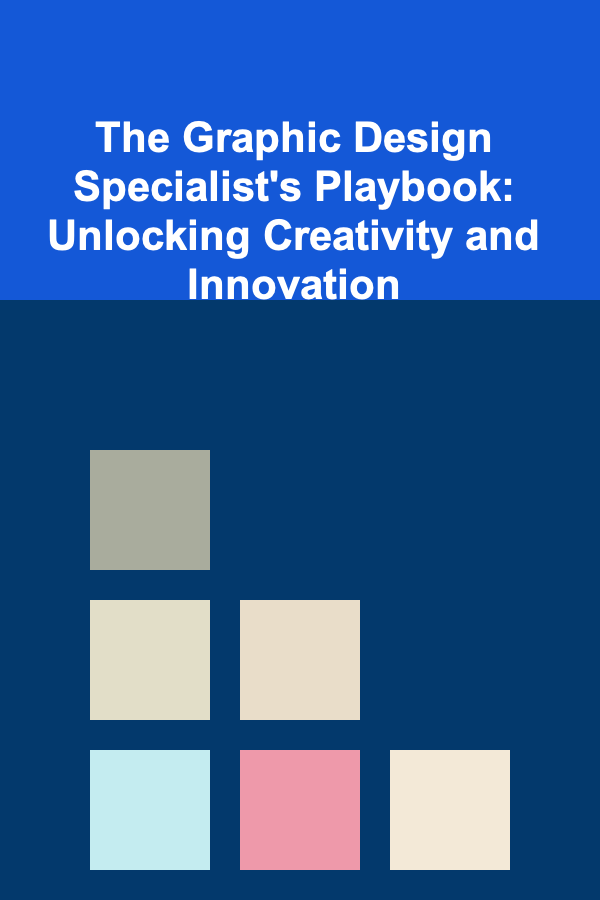
The Graphic Design Specialist's Playbook: Unlocking Creativity and Innovation
ebook include PDF & Audio bundle (Micro Guide)
$12.99$11.99
Limited Time Offer! Order within the next:

Graphic design is far more than just creating visually appealing images. It is about communication, problem-solving, and creating an experience that resonates with the viewer. In a world where the digital landscape constantly evolves, the role of a graphic design specialist has grown even more crucial. As a design professional, unlocking creativity and innovation is essential not only to stay competitive but also to drive the projects you work on to new heights.
In this actionable guide, we will dive deep into the essential skills, techniques, and strategies that can help you become a graphic design specialist who thrives on innovation and creativity. Whether you are designing for web, print, or motion graphics, this playbook will give you the tools to harness your creative potential and push the boundaries of what's possible.
Understanding the Role of a Graphic Design Specialist
Before delving into the specific tools and techniques, it's crucial to have a clear understanding of what a graphic design specialist does.
A graphic design specialist is responsible for visual communication that conveys ideas, messages, or concepts to a target audience. This could include anything from brand identity and logo design to digital interfaces and print layouts. The role requires a blend of both creativity and technical skills, with an emphasis on strategic thinking and the ability to adapt designs to meet the needs of clients, users, or businesses.
The core of a graphic designer's job is to create designs that:
- Solve problems: Every design decision should be made with the intent of solving a problem, whether it's increasing brand recognition, improving user experience, or enhancing communication.
- Communicate a message: Every piece of design should convey a clear message. Understanding the narrative behind the design and ensuring the visuals align with it is paramount.
- Connect with an audience: Understanding your target audience and designing with empathy is key to creating relevant, engaging, and meaningful visuals.
Building a Strong Creative Foundation
1. Master the Principles of Design
Understanding the fundamental principles of design is the foundation of every great graphic designer. These principles govern how you arrange elements in your design to create aesthetically pleasing and effective work.
Composition and Balance
Composition is the arrangement of elements within a design. Creating balance is key to a harmonious design that feels complete and well-structured. The Rule of Thirds and Golden Ratio are commonly used to guide placement of key elements in a way that feels both balanced and dynamic.
- Symmetry: Symmetrical compositions tend to be more formal and organized, while asymmetrical designs can create a sense of movement and interest.
- Whitespace (Negative Space): Whitespace is essential for creating clarity and structure. It allows the viewer's eye to breathe and helps reduce visual clutter.
Contrast and Emphasis
Contrast helps create emphasis, making certain elements stand out and draw attention. This could be achieved through differences in color, size, shape, and texture. A well-placed contrast can highlight key information and lead the viewer's eye where you want it to go.
- Color Contrast: Complementary color pairs (e.g., red and green, blue and orange) provide high contrast and make designs pop.
- Size Contrast: Larger elements tend to dominate smaller ones, so use size contrast strategically to guide attention.
Alignment and Unity
Everything in your design should feel unified and aligned. When elements are not aligned, it disrupts the viewer's experience. Use grid systems and guides to ensure that all elements line up logically and that the design flows naturally from one section to the next.
2. The Power of Color and Typography
Color Theory
Color has a profound impact on the emotions and perceptions of your audience. Understanding color theory is essential for crafting designs that evoke the right feelings.
- Primary, Secondary, and Tertiary Colors: The color wheel is divided into primary (red, blue, yellow), secondary (green, purple, orange), and tertiary colors. These relationships are fundamental when choosing complementary or harmonious color palettes.
- Color Psychology: Different colors evoke different emotions. Blue often symbolizes trust, while red can represent energy or urgency. Choosing the right color palette can enhance the overall message of your design.
Typography
Typography is one of the most significant elements in graphic design. The right typeface not only enhances readability but also communicates the tone of your design.
- Font Selection : When selecting fonts, ensure they align with the overall aesthetic and tone. For example, serif fonts are often associated with tradition and reliability, while sans-serif fonts are seen as modern and clean.
- Pairing Fonts: Combining two contrasting fonts, such as a bold headline font and a simple body font, can create visual interest and hierarchy.
- Legibility and Readability: Typography should be easy to read, with appropriate sizing, spacing, and contrast against the background. Keep in mind that readability is more important than style.
Tools of the Trade: Empowering Creativity
1. Adobe Creative Suite: The Designer's Powerhouse
The Adobe Creative Suite (Photoshop, Illustrator, InDesign) remains the go-to software for professional designers. Mastering these tools is non-negotiable for graphic design specialists, as they offer unparalleled flexibility and functionality.
Photoshop
Photoshop is ideal for photo editing, digital art, and raster-based designs. Learn to use advanced features like layer masks, smart objects, and blending modes to manipulate images and create stunning visual effects.
Illustrator
Illustrator is a vector-based design software that is crucial for logo design, icons, and illustrations. Master the pen tool , pathfinder tool , and shape building tools to create scalable graphics that retain quality at any size.
InDesign
InDesign is the best tool for print-based designs like brochures, posters, and magazines. It offers precise control over typography and page layouts, making it essential for multi-page documents.
2. Figma and Sketch: The Future of Web and UI Design
For web design and user interface (UI) design, Figma and Sketch are indispensable tools. These platforms offer cloud-based, collaborative design spaces that enable seamless teamwork, rapid prototyping, and high-quality designs.
- Figma is a browser-based platform that allows real-time collaboration. You can design, prototype, and collaborate all in one place, making it ideal for remote teams.
- Sketch is a vector-based design tool focused on UI/UX design. It's perfect for creating website layouts, mobile app interfaces, and other interactive design elements.
3. 3D Design and Motion Graphics: Expanding Your Horizons
With the rise of motion design and 3D graphics , many graphic designers are exploring new mediums to enhance their work. Tools like Cinema 4D and After Effects allow you to create dynamic, animated content and 3D models, offering new opportunities for innovation.
- Motion Graphics: Learn how to animate logos, create transitions, and add interactive elements to your designs. This can breathe life into branding, advertising, and web content.
- 3D Design: Creating 3D assets adds depth and realism to your projects. It can be especially effective in product design, packaging, and virtual environments.
Innovating in Design: Moving Beyond the Basics
1. Experimenting with New Media
The world of graphic design is ever-changing. As a graphic design specialist, it's crucial to stay curious and experiment with new techniques, technologies, and media to keep pushing the boundaries of creativity.
Augmented Reality (AR) and Virtual Reality (VR)
With the growth of AR and VR, there are now opportunities for designers to create interactive, immersive experiences. These can be used for marketing, entertainment, education, or even product design. Familiarize yourself with AR design tools like Adobe Aero and Spark AR.
Artificial Intelligence in Design
AI tools are being integrated into design workflows, making tasks like resizing images, creating color palettes, and generating design suggestions faster and more efficient. Explore tools like Adobe Sensei to harness the power of AI and streamline repetitive tasks, giving you more time for creative thinking.
2. Developing a Unique Design Voice
While mastering design principles and tools is essential, it's equally important to develop a unique design voice that sets you apart from other designers.
- Personal Projects: Experimenting with personal projects allows you to step outside of client constraints and explore your own creative vision. This is often where the most innovative work emerges.
- Continuous Learning: Design trends, technologies, and tools are constantly evolving. Stay up to date with the latest design movements by reading industry blogs, attending webinars, and joining design communities.
- Collaboration and Feedback: Working with other designers, developers, and clients helps you grow and learn from different perspectives. Don't be afraid to ask for feedback or collaborate on new projects to challenge your skills and creativity.
Conclusion
Becoming a successful graphic design specialist requires more than just technical skill. It requires a passion for creativity, a deep understanding of design principles, and a willingness to adapt to emerging trends and technologies. By mastering the basics, embracing modern tools, and continuously innovating, you can unlock your creative potential and create designs that are not only visually compelling but also strategically impactful.
Graphic design is an ever-evolving field that thrives on creativity and innovation. By staying curious, honing your skills, and constantly pushing the limits of what's possible, you will unlock new opportunities for yourself and the projects you work on. The future of graphic design is limitless---so go ahead and unlock your own creativity and innovation today!
Reading More From Our Other Websites
- [Soap Making Tip 101] When Ingredients Clash: Navigating Color, Scent, and Texture Challenges in Homemade Soap
- [Home Family Activity 101] How to Create a Cozy Family Reading Nook
- [Tiny Home Living Tip 101] How to Design a Tiny Home with Universal Design Principles for Aging in Place
- [Personal Care Tips 101] How to Apply Makeup Primer for Dry Skin
- [Horseback Riding Tip 101] The Art of Western Dressage: Combining Tradition with Modern Riding Principles
- [Home Rental Property 101] How to Use Social Media to Promote Your Rental Listings
- [Home Party Planning 101] How to Choose the Right Music and Playlist for Your Home Party
- [Home Space Saving 101] How to Maximize the Space Under Your Stairs for Storage
- [Personal Care Tips 101] How to Layer Lip Gloss with Lip Liner for a Defined Look
- [Home Pet Care 101] How to Keep Your Home Safe from Toxic Plants for Pets

How to Plan for Travel During Busy Seasonal Times
Read More
Social Movements: Understanding Collective Action and Social Change
Read More
Using Deep Learning to Build a Profitable Affiliate Marketing Business
Read More
How to Prioritize Your Daily To-Do List with the Eisenhower Matrix
Read More
10 Tips for Maximizing Your Artist Planner for Productivity
Read More
10 Tips for a Bachelor Party That's Actually Memorable
Read MoreOther Products

How to Plan for Travel During Busy Seasonal Times
Read More
Social Movements: Understanding Collective Action and Social Change
Read More
Using Deep Learning to Build a Profitable Affiliate Marketing Business
Read More
How to Prioritize Your Daily To-Do List with the Eisenhower Matrix
Read More
10 Tips for Maximizing Your Artist Planner for Productivity
Read More